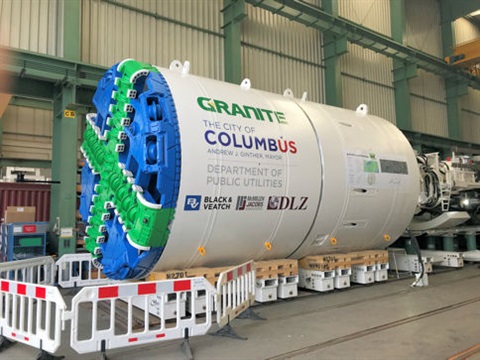Lower Olentangy Tunnel (LOT)

The City of Columbus is under two Ohio Environmental Protection Agency (OEPA) consent orders to improve water quality and reduce the potential for human contact with waterborne pollutants by reducing overflows from the sewer system into creeks and rivers during wet weather events. The Department of Public Utilities' plan for achieving the requirements of these consent decrees is described in the “Integrated Plan and 2015 Wet Weather Management Plan Updated Report”. One of the key elements of the plan is the Lower Olentangy Tunnel (LOT).
LOT will assist with several goals outlined in the 2015 plan to address OEPA consent order requirements which include:
- Prevent activations (up to a typical year storm) from seven Combined Sewer Overflow (CSO) structures, located along the lower portion of the Olentangy River by relieving the Olentangy Scioto Intercepting Sewer (OSIS). These CSO structures are located at First Avenue, Third Avenue, King Avenue, Indianola Avenue, Frambes Street, Doe Alley, and Hudson Street.
- Prevent mainline Designed Sewer Relief (DSR) activations (up to 10-year peak flow recurrence) at DSR 156 & DSR 284 on the Franklin Main Interceptor, and DSR 873 on the Clinton Number 3 Trunk Sewer.
- Assist in mitigation of DSRs (up to 10-year peak flow recurrence) in designated Blueprint Columbus areas, including DSR 103 and DSR 107, and elimination of DSR 109 and DSR 111 in the Fifth by Northwest Blueprint area.
- Assist in mitigating Water-In-Basement (WIB) incidents (up to 10-year peak flow recurrence) in the Fifth by Northwest Blueprint area.
- Assist in mitigating chronic sanitary sewer manholes flooding (up to 10-year peak flow recurrence) in Tuttle Park.
LOT will connect into the upstream end of the previously constructed OSIS Augmentation Relief Sewer (OARS) at Vine Street. The upstream end of LOT will be located north of Lane Avenue where three existing sewers, the Franklin Main, the Olentangy Main and the OSIS are in close proximity to each other.
The design process for LOT began with identifying and evaluating potential alignments between these two end points and sampling geology in the area.
During design, the city evaluated six primary alignments and numerous variations. The primary factors evaluated were: hydraulic capacity, geologic characteristics of native soils and bedrock, groundwater, construction impacts, property acquisition requirements, alternative cost estimates, alternative schedules and a comparative risk evaluation.
See the selected alignment(PDF, 2MB)
The LOT main tunnel will require construction of approximately 17,000 feet of 12-foot diameter tunnel at an average depth of 50 feet. This portion will be mined with a tunnel boring machine (photo) and constructed of precast concrete segments. There are three main shafts (large manholes and other structures to provide access and tunnel controls) along LOT at Tuttle Park north of Lane Avenue, at Gowdy Field near Third Avenue & Olentangy River Road, and at Vine Street.
A 90-inch diameter microtunnel will also be constructed to relieve the OSIS near Second Avenue. The microtunnel will begin at the 2nd Avenue and Perry Street intersection and flow west into LOT at the Gowdy Field Shaft.
A 36-inch relief sewer will also be constructed to relieve a DSR in Third Avenue into LOT. This DSR is on the Kinnear Subtrunk Sewer which serves the Fifth by Northwest Blueprint area.
The LOT project was bid during the Summer of 2020. Construction began in early 2021 and be completed in September 2026.
Financing for the LOT project is being provided through a below market-rate loan through the Ohio EPA’s Water Pollution Control Loan Fund (WPCLF) Program.
Ohio EPA has issued a Final Finding of No Significant Impact for the City of Columbus, Department of Public Utilities’ Lower Olentangy Tunnel (“LOT”) project (CIP# 650724-100000; WPCLF Loan Number CS390274-0362). View the Final Finding of No Significant Impact(PDF, 922KB)
For questions regarding this project - Email Project Manager, Jeremy Cawley, at JKCawley@columbus.gov.